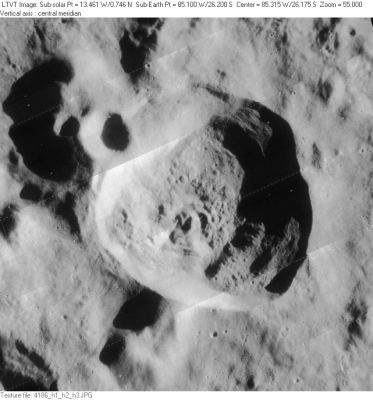Nicholson
Contents
Nicholson (of the pair Nicholson-Pettit)
|
Lat: 26.2°S, Long: 85.1°W, Diam: 38 km, Depth: 3.57 km, [/R%C3%BCkl%2050 Rükl: 50], [/Stratigraphy Eratosthenian] |
Table of Contents
[#Nicholson (of the pair Nicholson-Pettit) Nicholson (of the pair Nicholson-Pettit)]
[#Nicholson (of the pair Nicholson-Pettit)-Images Images]
[#Nicholson (of the pair Nicholson-Pettit)-Maps Maps]
[#Nicholson (of the pair Nicholson-Pettit)-Description Description]
[#Nicholson (of the pair Nicholson-Pettit)-Description: Wikipedia Description: Wikipedia]
[#Nicholson (of the pair Nicholson-Pettit)-Additional Information Additional Information]
[#Nicholson (of the pair Nicholson-Pettit)-Nicholson and Pettit Nicholson and Pettit]
[#Nicholson (of the pair Nicholson-Pettit)-Nomenclature Nomenclature]
[#Nicholson (of the pair Nicholson-Pettit)-LPOD Articles LPOD Articles]
[#Nicholson (of the pair Nicholson-Pettit)-Bibliography Bibliography]

LO-IV-186H
Images
LPOD Photo Gallery Lunar Orbiter Images
Maps
([/LAC%20zone LAC zone] 91D1) USGS Digital Atlas PDF
Description
Description: Wikipedia
Additional Information
- Depth data from [/Kurt%20Fisher%20crater%20depths Kurt Fisher database]
Westfall, 2000: 3.57 km - TSI = 25, CPI = 5, FI = 20; MI =50 [/Smith%20and%20Sanchez%2C%201973 Smith and Sanchez, 1973]
Nicholson and Pettit
Here's the reason why a "twin"-couple of pronounced craters in Mare Orientale's Rook Mountains were called Nicholson and Pettit:
- In the early 1920s, Seth Nicholson and Edison Pettit made the first systematic infrared observations of celestial objects. They used a vacuum thermocouple to measure the infrared radiation and thus the temperature of the Moon which led to the theory that the Moon was covered with a thin layer of dust acting as an insulator, and also of the planets, sunspots and stars. Their temperatures measurements of nearby giant stars led to some of the first determinations of stellar diameters.
Nomenclature
Seth Barnes Nicholson (November 12, 1891– July 2, 1963) was an American astronomer. He spent his entire career at Mount Wilson Observatory, where he discovered three more Jovian moons: Lysithea and Carme in 1938 and Ananke in 1951, as well as a Trojan asteroid 1647 Menelaus, and computed orbits of several comets and of Pluto.
LPOD Articles
Bibliography
About Seth B. Nicholson:
Page 60 in To a Rocky Moon, a geologist's history of lunar exploration (Don E. Wilhelms) :
- Because my first love was astronomy I chose Pomona College in southern California for my undergraduate studies (on the basis of personal advice from astronomer Seth Nicholson, who is often credited as a codeterminer of the moon's surface temperature and who added that I would become a social misfit if I went to Caltech as I had been considering.
This page has been edited 1 times. The last modification was made by - tychocrater tychocrater on Jun 13, 2009 3:24 pm - afx3u2